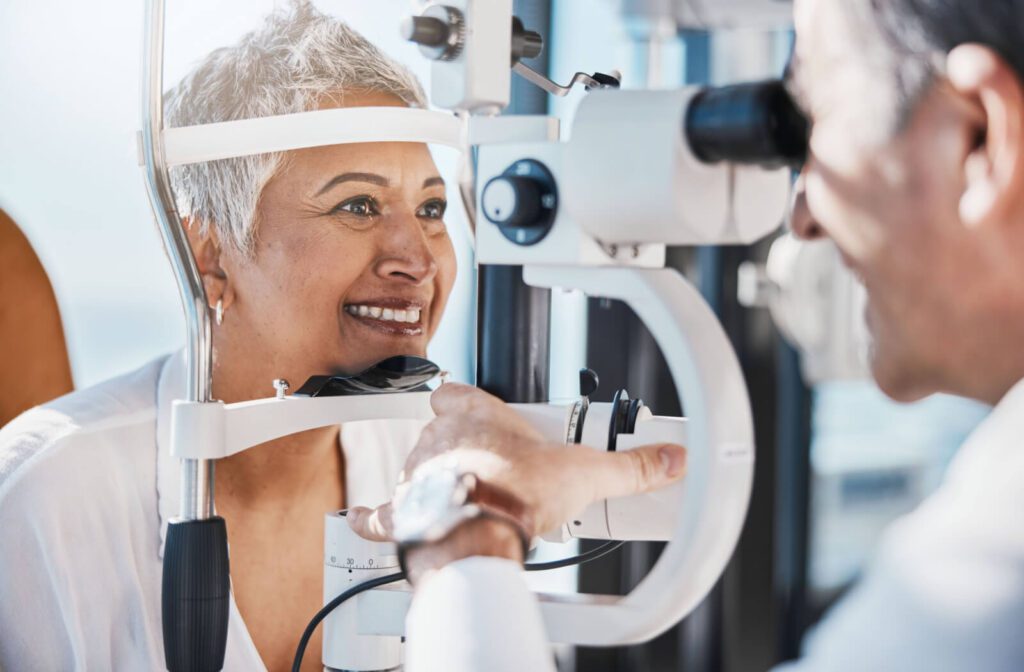Table of Contents

Astigmatism vs. Myopia: What’s the Difference? Signs, Symptoms, & Treatments [散光与近视:有什么区别?体征、症状和治疗]
Blurry vision can mean you need glasses or even surgery to see clearly. Refractive errors like myopia and astigmatism can affect your daily life, but they’re treatable with help from your eye doctor.
Astigmatism and myopia cause blurry vision, but what’s the difference between these refractive errors?
Astigmatism vs. Myopia
Astigmatism and myopia are both refractive errors that affect your vision. They can alter the eye’s shape, changing how light hits the retina as it enters your eye. However, myopia has some differences compared to astigmatism.
Myopia can progress in childhood, worsening vision and increasing the risk of eye conditions that can affect your sight significantly. Additionally, myopia affects far-away vision, while astigmatism can cause blurry vision from all distances.
Myopia typically develops in early childhood and progresses until early adulthood, meaning it can worsen with time. This condition can become high myopia, which increases the risk of several eye conditions, including:
What Is Astigmatism?
Astigmatism is a refractive error causing blurry vision from all distances. The eye’s shape causes blurry vision. The eye is usually a sphere, like a baseball, while an eye with astigmatism is shaped like a football or egg. Unlike other refractive errors, astigmatism can develop with myopia or hyperopia.
The symptoms of astigmatism can include:
- Blurry vision
- Discomfort
- Squinting to see
- Strained eyes
- Headaches
Your eye doctor can help diagnose astigmatism by assessing your eyes during an eye exam.
What Causes Astigmatism?
The shape of the cornea or lens can affect how light enters your eye.
Instead of landing on the retina, light entering an eye with astigmatism can land in front of or behind the retina. When light doesn’t land on the retina, it leads to blurry vision. Astigmatism affects each patient differently, meaning each eye has a unique shape and vision.
While anyone can develop astigmatism, it can be passed down through families. You’re more at risk if your parents have astigmatism.
Besides genetics, astigmatism can develop from an eye injury, disease, or surgery.
What Is Myopia?
Myopia is a refractive error that causes blurry vision from far distances while nearby images appear clearly. Like astigmatism, it occurs due to the shape of your eye. Many patients develop myopia in childhood, where it typically progresses until adulthood.
Myopia symptoms include:
- Headaches
- Squinting to see
- Strained eyes
- Trouble seeing far-away images
Children with myopia may not notice these symptoms because they’re used to blurry vision. Book an eye exam if your child struggles in school or you notice other myopia signs.
What Causes Myopia?
How Can You Treat Astigmatism?
You can’t cure astigmatism, but your eye doctor can help you see more clearly. They can recommend strategies to help improve your vision, such as:
- Corrective lenses: Corrective lenses like glasses or contact lenses can help you see clearly from all distances. Your optometrist can recommend lenses that suit your needs.
- Refractive surgery: Refractive surgery can help improve your sight with a specialized laser. Your eye doctor can recommend the ideal laser surgery for your vision needs and eligibility.
How Can You Treat Myopia?
Like astigmatism, your eye doctor can’t cure myopia, but they can treat it with contacts, glasses, and refractive surgery.
To slow myopia progression, your eye doctor has several treatments available. Your eye doctor may recommend eye drops, specialized contact lenses, or specialized glasses to address myopia progression. They can recommend treatments for your child’s needs—for example, glasses can help control and correct myopia, but they aren’t ideal for every child.
Some myopia control treatments include:
- Atropine eye drops: Atropine eye drops help slow myopic progression by freezing the eye’s focusing muscles and blocking certain growth receptors in the eyes. This treatment can help slow myopic progression, but your child will still need glasses.
- Specialized contact lenses: Specialized contact lenses, like MiSight, help control and correct myopia with their unique design. The lens has different areas dedicated to correcting vision and controlling myopia, almost like a bullseye.
- Ortho-k lenses: Orthokeratology (ortho-k) lenses can slow myopic progression by gently reshaping the cornea overnight. You wear these lenses when you sleep, helping you wake up with clear vision in the morning—meaning you don’t need corrective lenses during the day.

Enjoy Clear, Comfortable Vision
Your optometrist is available to help whether you have myopia, astigmatism, or both. They can recommend a customized treatment plan to help improve your vision with glasses, contacts, or refractive surgery. If your child shows signs of myopia, your eye doctor can help prevent their vision from worsening.
Contact us at Golden Vision Optometry today if you or your child are experiencing blurry vision. Our knowledgeable team can recommend a personalized treatment plan to help give you clearer vision.








